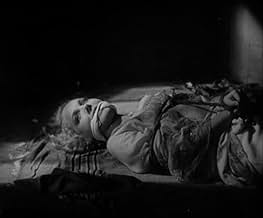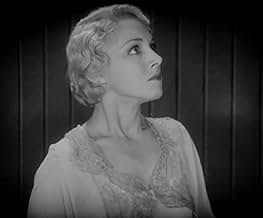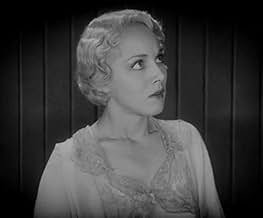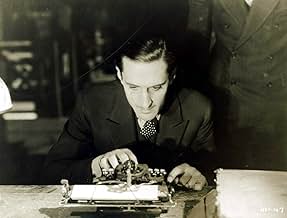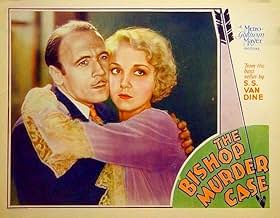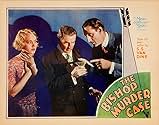Füge eine Handlung in deiner Sprache hinzuWhen the body of a man nicknamed "Cock Robin" is found with an arrow in the heart on an archery range along with a chess bishop as a clue, Philo Vance investigates.When the body of a man nicknamed "Cock Robin" is found with an arrow in the heart on an archery range along with a chess bishop as a clue, Philo Vance investigates.When the body of a man nicknamed "Cock Robin" is found with an arrow in the heart on an archery range along with a chess bishop as a clue, Philo Vance investigates.
- Regie
- Drehbuch
- Hauptbesetzung
Charles Quatermaine
- John Pardee
- (as Charles Quartermaine)
Sidney Bracey
- Pyne
- (as Sydney Bracey)
Richard Cramer
- Detective in Park
- (Nicht genannt)
Frank Fanning
- Officer Manning
- (Nicht genannt)
Marcia Mae Jones
- Hungry Child in Park
- (Nicht genannt)
Broderick O'Farrell
- Dr. Van Pelt
- (Nicht genannt)
Empfohlene Bewertungen
This film is the 3rd of the Philo Vance mysteries to be filmed. The first two, Canary and Greene (filmed in 1929) were pretty hard going. They starred William Powell and he would return to star in the Benson Murder case and the best of the Vance series, The Kennel Murder Case. This one, starring Basil Rathbone is a step above the first two but it is still a static film as were many of that era......transitioning to sound was an awkward time for the movies and people talked, and talked, and talked, ad infinitum. Rathbone, a very attractive, suave actor fits the role well and he plays Vance as a little less of the high-brow, somewhat obnoxious character that was portrayed in VanDine's books. The mystery is another one of those typical Philo Vance puzzlers which never turn out as you thought they might but that is the fun of it all. It's interesting to see Roland Young in a role that is different from his usual movie persona. James Donlan, as Sgt. Heath is very irritating....nobody is that stupid and you wonder how he became a policeman, let alone a sergeant. I much prefer Eugene Palette from the William Powell/Vance films in that role. The rest of the supporting cast is adequate. You probably have to be a Vance devotee and a fan of early sound pictures to appreciate this film. Being both, I enjoyed it but would recommend The Kennel Murder Case for an introduction to Philo Vance. The series hit its stride with that film and then went downhill from there. Also, see The Canary Murder Case for historical film value as it was the last film made by the amazing Louise Brooks before she went on to cinema history in Germany. But, have fun with this movie...it is worth a look if you are a fan of the genre.
When you consider that sound had only come in a couple of years before THE BISHOP MURDER CASE, the fact that the film still has a soundtrack that needs restoration is no surprise. But I did manage to see a good print of the film on TCM and the gleaming B&W photography belied the fact that this was made in 1930.
But my sole purpose for watching was to see what BASIL RATHBONE looked like in an early detective role as Philo Vance. The mystery itself seemed a lot like an Agatha Christie whodunit because the murders were staged by a clever killer who just wasn't smart enough to outwit Philo Vance. The final revelation involves a glass of wine with poison in it ("the vessel with the pessel" film that Rathbone did with Danny Kaye comes to mind here). Rathbone's cleverness and manner of solving the crime is reminiscent of the way he played Sherlock Holmes so well in all those Sherlock films.
He also had a crisp delivery that was lacking in the other players. Only ROLAND YOUNG managed to sound as if silent films were a thing of the past. The others were clearly still in the silent mode of acting which makes Rathbone's performance even more remarkable.
Not a great mystery by any means and the sets, despite some fine photography, are on the primitive side--but addicts of detective stories should enjoy this one.
But my sole purpose for watching was to see what BASIL RATHBONE looked like in an early detective role as Philo Vance. The mystery itself seemed a lot like an Agatha Christie whodunit because the murders were staged by a clever killer who just wasn't smart enough to outwit Philo Vance. The final revelation involves a glass of wine with poison in it ("the vessel with the pessel" film that Rathbone did with Danny Kaye comes to mind here). Rathbone's cleverness and manner of solving the crime is reminiscent of the way he played Sherlock Holmes so well in all those Sherlock films.
He also had a crisp delivery that was lacking in the other players. Only ROLAND YOUNG managed to sound as if silent films were a thing of the past. The others were clearly still in the silent mode of acting which makes Rathbone's performance even more remarkable.
Not a great mystery by any means and the sets, despite some fine photography, are on the primitive side--but addicts of detective stories should enjoy this one.
I found all of the Philo Vance films watchable, with the zippy and witty Kennel head and shoulders above the rest. Bishop was pretty good too but suffered from a cast of actors stuck in the silent era and displaying the full range of intensely melodramatic emotions that are were so essential to the making of and enjoyment of watching a silent film. Static cameras are as nothing to tortured eyes and semaphore arm histrionics.
Mr. (Cock) Robin is found flat out murdered, apparently shot with an incredibly long arrow but Vance played by skinny and incisive Basil Rathbone knows better. He predicts a series of ghastly and inhuman murders will follow conceived by a intellect bent on playing games with his pursuers by couching his dastardly deeds in very handy nursery rhymes. He and one of the suspects, evergreen Roland Young are the only two to act naturally throughout, if still very slightly stagey. The photography is occasionally startlingly good, if still static. None of these criticisms bother me, I love it just the same as a well crafted atmospheric entertaining potboiler. Favourite bits: The scene in Dillard's library with the thunderstorm raging outside; the sedate and well-mannered way Vance and the cops enter Dillard's aerodrome of a house to search for the murderer.
I hadn't seen this since 1995, the last time UK Channel 4 gave anyone interested their opportunity to watch it. TCM UK unlike TCM US will never have room for it in their admirably varied schedule either (hem). But it's worth hunting down with all its faults for 90 minutes in the company of the world of 1929.
Mr. (Cock) Robin is found flat out murdered, apparently shot with an incredibly long arrow but Vance played by skinny and incisive Basil Rathbone knows better. He predicts a series of ghastly and inhuman murders will follow conceived by a intellect bent on playing games with his pursuers by couching his dastardly deeds in very handy nursery rhymes. He and one of the suspects, evergreen Roland Young are the only two to act naturally throughout, if still very slightly stagey. The photography is occasionally startlingly good, if still static. None of these criticisms bother me, I love it just the same as a well crafted atmospheric entertaining potboiler. Favourite bits: The scene in Dillard's library with the thunderstorm raging outside; the sedate and well-mannered way Vance and the cops enter Dillard's aerodrome of a house to search for the murderer.
I hadn't seen this since 1995, the last time UK Channel 4 gave anyone interested their opportunity to watch it. TCM UK unlike TCM US will never have room for it in their admirably varied schedule either (hem). But it's worth hunting down with all its faults for 90 minutes in the company of the world of 1929.
S. S. Van Dine's socialite detective is brought to film for the third time - this time having Basil Rathbone play Philo Vance. While I will not argue with some of the critical assertions that the film is static, stationary, and decidedly creaky, not too mention very far-fetched and predictable, The Bishop Murder Case was made in 1930 when sound was just coming into its own. That is very evident in this film as much of the dialog is hard to hear and comprehend. The stationary microphone was used throughout with director Nick Grinde using lots of expansive scenes with the actors standing around the screened microphone as was the case for sound pictures then. That being said, the film is a pretty decent detective mystery for its time. Rathbone makes an affable Vance. His character is given little depth, however. The mystery, while not entirely and sufficiently explained to me has some things going for it with red herrings involving chess pieces, archery, Ibsen plays, and murders emulating nursery rhymes of a kind. While Grinde directs with the limitations at hand, I did like some of his wide shots. The balcony of the building scene when the professor discovers a man killed by an arrow looked quite impressive, and you can see some wide shots that most definitely mirror German film expressionism of the 1920s with some large, long windows shot in the backdrops of several scenes. All the actors are competent with some real nice character turns by the likes of Charles Quartermaine as a chess expert, George F. Marion as a hunchbacked pseudo-intellectual, James Donlan as a police sergeant(giving the film some of its much needed light moments), and Roland Young, Cosmo Topper himself, turning in a sly, witty performance as a possible suspect. The script is unfortunately riddled with too much ambiguity to make any real sense, but when all is said and done, The Bishop Murder case is mildly entertaining - again making consideration for the time it was made.
Good effort given the primitive technology. This very early talkie does not creak like most of them did, and you believe that the same team could have done much better only a few years later.
Check out the innovative scene of Hyams at the three-way mirror. Beautiful scene that directors even today should view for technique. There are several little skilled touches added to this film that make you realize that the only limitation on the talent was the primitive lower-than-low tech.
Rathbone and Hyams seem more modern than the movie and they definitely do not creak.
Must reluctantly give it a "5" because of old set-bound look of the film and the lack of music but it is rewarding if you can overlook such drawbacks.
Check out the innovative scene of Hyams at the three-way mirror. Beautiful scene that directors even today should view for technique. There are several little skilled touches added to this film that make you realize that the only limitation on the talent was the primitive lower-than-low tech.
Rathbone and Hyams seem more modern than the movie and they definitely do not creak.
Must reluctantly give it a "5" because of old set-bound look of the film and the lack of music but it is rewarding if you can overlook such drawbacks.
Wusstest du schon
- WissenswertesSeveral times Sigurd Arnesson (Roland Young) sarcastically calls Philo Vance (Basil Rathbone) "Sherlock Holmes". Nine years later, Rathbone would take the role of Holmes in Der Hund von Baskerville (1939) (and 14 sequels), and it became his iconic role.
- PatzerWhen Vance and fellow detectives investigate the body of Robin, who has been shot with an arrow, the angle of the arrow changes. Sometimes it's straight up out of the body, other times it's at almost a 45 degree angle.
- Zitate
Philo Vance: [to Heath] Sergeant, you're much too trusting for this deceitful world. If everything happened as easy as that, life would be very simple and very dull.
- VerbindungenFollowed by The Benson Murder Case (1930)
- SoundtracksWaltz of the Flowers
(1891-2) (uncredited)
from "The Nutcracker Suite, Op.71a"
Written by Pyotr Ilyich Tchaikovsky
Played on piano by Basil Rathbone
Top-Auswahl
Melde dich zum Bewerten an und greife auf die Watchlist für personalisierte Empfehlungen zu.
- How long is The Bishop Murder Case?Powered by Alexa
Details
- Erscheinungsdatum
- Herkunftsland
- Sprache
- Auch bekannt als
- Дело об убийстве епископа
- Drehorte
- Grant's Tomb, Riverside Drive, New York City, New York, USA(Vance's car drives past in a second unit shot)
- Produktionsfirma
- Weitere beteiligte Unternehmen bei IMDbPro anzeigen
- Laufzeit1 Stunde 28 Minuten
- Farbe
Zu dieser Seite beitragen
Bearbeitung vorschlagen oder fehlenden Inhalt hinzufügen


